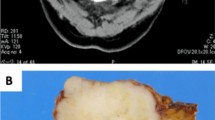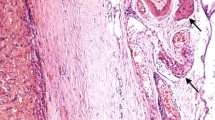Abstract
Epithelial–myoepithelial carcinoma (EMC) is a rare neoplasm arising predominantly in the salivary glands, in particular in the parotid gland. We report the morphological features of an epithelial–myoepithelial carcinoma of the parotid gland with one lymph-node metastasis including a molecular genetic study of this tumor. Immunohistochemical and ultrastructural results confirmed the epithelial–myoepithelial dualism of the carcinoma. The loss of heterozygosity (LOH) analysis revealed different LOH results for the solid and the tubular growth pattern of the primary tumor, but showed identical findings for the solid primary tumor component and the lymph node metastasis which had also a solid appearance. LOH could be demonstrated in the whole primary tumor at D13S217 (13q12) and D18S58 (18q21). In three other microsatellite loci [D9S162 (9p22-p21), D10S251 and D10S541 (surrounding the PTEN/MMAC1 gene on 10q23-q24)], clearly recognizable LOH was found in the solid part and in the metastasis, whereas the tubular component demonstrated only a slight decrease of the same allele. No mutation or methylation of the p16 gene or alteration of the PTEN/MMAC1 gene could be found. Nevertheless, our results provoke a discussion, whether these genetic alterations could be considered as determinants of histologically and prognostically divergent types in EMC.



Similar content being viewed by others
References
Alos L, Carrillo R, Ramos J, Baez JM, Mallofre C, Fernandez PL, Cardesa A (1999) High-grade carcinoma component in epithelial-myoepithelial carcinoma of salivary glands: clinicopathological, immunohistochemical and flow-cytometric study of three cases. Virchows Arch 434:291–299
Canzian F, Salovaara R, Hemminkki A, Kristo P, Chadwick RB, Aaltonen LA, de la Chapelle A (1996) Semiautomated assessment of loss of heterozygosity and replication error in tumors. Cancer Res 56:3331–3337
Donath K, Seifert G, Schmitz R (1972) Zur Diagnose und Ultrastruktur des tubulären Speichelgangskarzinoms. Epithelial-myoepitheliales Schaltstückkarzinom. Virchows Arch 356:16–31
Ellis GL, Auclair PL (1996) Tumors of the salivary glands. Atlas of tumors pathology, 3rd series, Fascicle 17. Armed Forced Institute of Pathology, Washington, DC, pp 268–281
Fonseca I, Soares J (1993) Proliferating cell nuclear antigen immunohistochemistry in epithelial-myoepithelial carcinoma of the salivary glands. Arch Pathol Lab Med 117:993–995
Gemma A, Takenoshita S, Hagiwara K, Okamoto A, Spillare EA, McMemamin MG, Hussain SP, Forrester K, Zariwala M, Xiong Y, Harris CC (1996) Molecular analysis of the cyclin-dependent kinase inhibitor genes p15 INK4b/MTS2, p16 INK4/MTS1, p18 and p19 in human cancer cell lines. Int J Cancer 68:605–611
Herman JG, Graff JR, Myöhänen S, Nelkin BD, Baylin SB (1996) Methylation-specific PCR: a novel PCR assay for methylation status of CpG islands. Proc Natl Acad Sci U S A 93:9821–9826
Kleist B, Poetsch M, Lang C, Bankau A, Lorenz G, Süess-Fridrich K, Jundt G, Wolf E (2002) Clear cell chondrosarcoma of the larynx. A case report of a rare histologic variant in an uncommon localization. Am J Surg Pathol 26:386–392
Ladanyi M, Antonescu CR, Leung DH, Woodruff JM, Kawai A, Healey JH, Brennan MF, Bridge JA, Neff JR, Barr FG, Goldsmith JD, Brooks JS, Goldblum JR, Ali SZ, Shipley J, Cooper CS, Fisher C, Skytting B, Larsson O (2002) Impact of SYT-SSX fusion type on the clinical behavior of synovial sarcoma: a multi-institutional retrospective study of 243 patients. Cancer Res 62:135–140
Luna MA, Ordonez NG, Mackay B, Batsakis JG, Guillamondegui O (1985) Salivary epithelial myoepithelial carcinomas of intercalated ducts: a clinical, electron microscopic, and immunocytochemical study. Oral Surg Oral Med Oral Pathol 59:482–490
Martins C, Fonseca I, Roque L, Pinto AE, Soares J (1996) Malignant salivary gland neoplasms: a cytogenetic study of 19 cases. Eur J Cancer B Oral Oncol 32:128–132
Nagao T, Sugano I, Ishida Y, Tajima Y, Munakata S, Asoh A, Yamazaki K, Muto H, Konno A, Kondo Y, Nagao K (2000) Primary large-cell neuroendocrine carcinoma of the parotid gland: immunohistochemical and molecular analysis of two cases. Mod Pathol 13:554–561
Saito T, Oda Y, Sugimachi K, Kawaguchi K, Tamiya S, Tanaka K, Matsuda S, Sakamoto A, Iwamoto Y, Tsuneyoshi M (2001) E-cadherin gene mutations frequently occur in synovial sarcoma as a determinant of histological features. Am J Pathol 159:2117–2124
Steck PA, Pershouse MA, Jasser SA, Yung WKA, Lin H, Ligon AH, Langford LA, Baumgard ML, Hattier T, Davis T, Frye C, Hu R, Swedlund B, Teng DHF, Tavtigian SV (1997) Identification of a candidate tumor suppressor gene, MMAC1, at chromosome 10q23.3 that is mutated in multiple advanced cancers. Nat Genet 15:356–362
Suzuki H, Fujioka Y (1998) Deletion of the p16 gene and microsatellite instability in carcinoma arising in pleomorphic adenoma of the parotid gland. Diagn Mol Pathol 7:224–231
Tralongo V, Daniele E (1998) Epithelial-myoepithelial carcinoma of the salivary glands: a review of the literature. Anticancer Res 18:603–608
Tralongo V, Rodolico V, Nagar C, Mancuso A, Salvato M, Daniele E (1997) Epithelial-myoepithelial carcinoma of the salivary glands: a clinico-pathologic, immunohistochemical and DNA flow cytometric study of three cases. Anticancer Res 17:761–768
Vogelstein B, Fearon ER, Kern SE, Hamilton SR, Preisinger AC, Nakamura Y, White R (1989) Allelotype of colorectal carcinomas. Science 244:207–211
Author information
Authors and Affiliations
Corresponding author
Rights and permissions
About this article
Cite this article
Kleist, B., Poetsch, M., Breitsprecher, C. et al. Epithelial–myoepithelial carcinoma of the parotid gland—evidence of contrasting DNA patterns in two different histological parts. Virchows Arch 442, 585–590 (2003). https://doi.org/10.1007/s00428-003-0800-8
Received:
Accepted:
Published:
Issue Date:
DOI: https://doi.org/10.1007/s00428-003-0800-8




